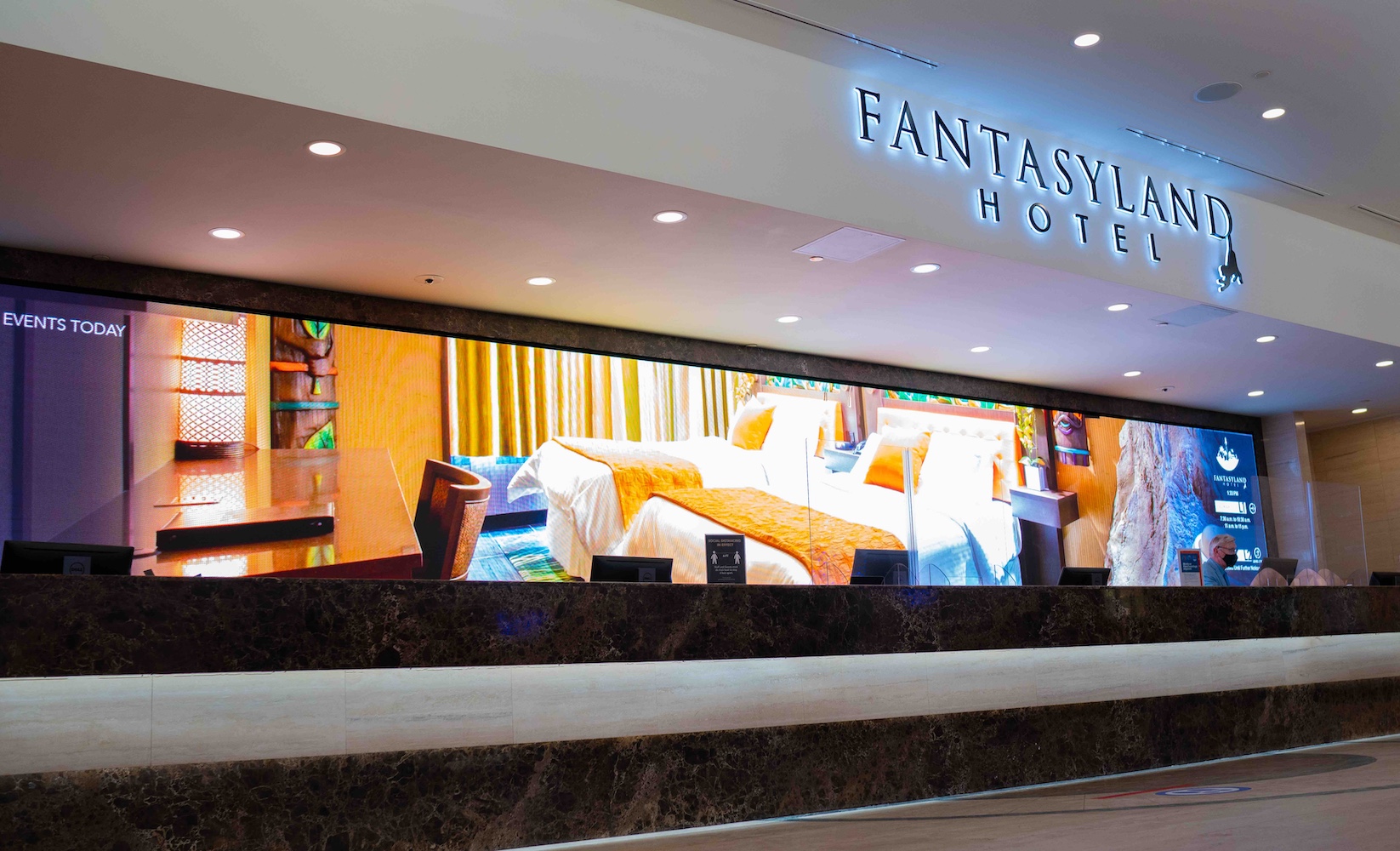Deploying Digital Signage Software for Large-Scale Networks

As digital signage technology has matured, software developers now offer increasingly sophisticated functionality that is significantly easier to install, manage, and utilize. This has helped systems integrators, IT technicians, and other installers to not only streamline large-scale network deployments, but add value through an increasingly broader array of applications.
Digital signage software in particular can more freely interact with third-party systems. Combined with other cutting-edge developments around AI and automation, businesses now have direct access to detailed analytics that allow them to adjust their technology and business operations on a real-time basis.
Through the COVID-19 pandemic, digital signage software has increasingly played a leading role in helping businesses return to operations. Retail stores can suddenly comply with new health and safety standards through temperature sensors, density monitoring, traffic management, and distance measuring. The functionality can be as strikingly granular, down to detecting whether employees and visitors are wearing masks—and even detect the color and fabric of each mask. These features, once again, let users make necessary adjustments to their daily operations easily and on the fly, enabling them to focus on their core businesses.
While the user experience associated with digital signage software may be intuitive, large-scale deployments comprised of hundreds—or, in some cases, thousands—of displays, either on campus, across multiple sites, or on a national level mandate thoughtful planning and consideration. For the design, integration, and management of these systems to be successful, it’s important that the appropriate stakeholders invest the effort in following a number of crucial steps along the way. Here are some of the best practices to take into consideration . . .
Decisions, Decisions
Deploying a large-scale network encompasses six main steps:
- Software selection
- Hardware selection
- Determining content requirements
- Assessing user requirements (including roles, company hierarchy, and approval workflows)
- Automation requirements (including APIs and integration needs)
- Day Two support
During this process, it’s crucial to think beyond deployment so that the care and feeding of these systems is seamless, and so that the organization achieves its desired return on investment. Prior to deployment, integrators and tech managers should develop solutions that address several key questions:
- How will the network be supported, and who will manage it?
- Can this solution meet all screen-based communication needs?
- Is this solution flexible enough to cover all potential use cases?
- Is this solution scalable and future-proof?
- How to optimally manage and monitor the health of the network?
- Does this solution offer robust tools to save time and money?
Selecting a CMS
Even minor issues can create devastating scenarios on large-scale networks, which makes software reliability paramount. An organization’s risk exposure to failures is increased with System on a Chip (SoC)-based solutions, as software glitches can crash displays, and require on-site intervention. This is why reliability should be top-of mind when choosing a content management system (CMS).
A daily selection of features, industry news, and analysis for AV/IT professionals. Sign up below.
It’s also necessary to consider how—and who—will use the CMS. While it’s important to select a CMS that offers an intuitive workflow, professional use cases also require a certain level of sophistication. Your CMS should support the scalability, flexibility, and functionality required now and well into the future.
To that end, systems integrators and tech managers must consider the organization’s present needs, and what will be required when the network reaches scale with multiple users, role management, open architecture, APIs, automation, and operating expenses/total cost of ownership. At the same time, the CMS must remain flexible and user-friendly while enabling users to create rules, automate functions, access advanced user monitoring and management features, and leverage APIs that boost workflow efficiency when a network has matured.
One common mistake is letting hardware drive the decision behind software selection. In this scenario, the hardware dictates which CMS solutions are supported, immediately limiting software options. This can result in an increased total cost of ownership, as the CMS may not be optimal for the desired use case.
Another mistake to avoid is selecting software that forces the user into a specific hardware choice. Software should offer flexibility; a large deployment often has multiple use cases and stakeholders, and software that is interoperable across multiple hardware platforms can produce a significant savings of time and money.
Those charged with hardware procurement should seek out multiple quotes from comparable offerings, and be willing to negotiate the best terms. Network operators need to select hardware that takes into considerations elements such as aesthetics, content, and costs associated with each use case.
Making the AV Work With IT
There are several IT concerns that tech managers and AV integrators must address during a successful digital signage deployment:
Player endpoint security: media players should be placed in secure areas (such as a server/IT room, behind walls, or in secured enclosures) to prevent unauthorized access to the equipment.
Connectivity: Most digital signage players require an internet connection to function properly. Tech managers and AV integrators should be aware of what network locations the players will need to access (such as the CMS server, or certain data feeds). All other connectivity to external or unauthorized sources, or other network locations, should be locked down.
When deploying a digital signage network designed to scale to multiple sites, it’s necessary to ensure that the server’s back end is equipped to support the number of players that will be connected today, and into the future—in other words, it’s important that the infrastructure is ready to scale up when needed. It’s also necessary to be familiar with the network topology between each of the sites, and to pay extra attention to the security concerns associated with having devices in multiple locations, but connected to the same central CMS server.
Cloud or On-Premise?
When an organization has limited (or no) IT specialists on staff, cloud-based digital signage solutions are ideal. A cloud-based system is also well-suited for applications that do not require digital signage players to connect to sensitive internal resources on the enterprise network.
On-premise solutions are best for organizations demanding the highest level of security, such as military and defense agencies, financial and healthcare institutions, and government offices. Generally, these organizations don’t want any element of their digital signage gaining access to networks outside of the system’s own secure internal network. On-premise solutions are therefore a better choice for companies that want to create deep software customizations, and leverage server-side APIs.
Best Practices for Security
The larger the project scope, the more vulnerable it is to malicious parties—especially when digital signage displays are visible to the public. In many cases, insurance companies require a third-party security audit to assess how secure these systems truly are.
There are several best practices to keeping a large-scale digital signage network safe:
- Only authorized users should gain access to the CMS for content and player management.
- Users should not upload or store highly sensitive information in the CMS.
- Ensure that all media player endpoints are locked down from a network perspective.
Expanding on the last point, only whitelisted or verified IP addresses should be accessible by the endpoints. That includes the CMS server, as well as specific data feeds.
Digital signage software developers work hard to remain compliant with the local and federal laws that apply to network and data security. Most systems provide easy integration points for Single Sign-on, Active Directory integration, and third-party multi-factor authentication systems to ensure that the identity of authorized users is verified at multiple stages prior to granting log-in access to the CMS.
Training Equals Optimization
An organization is more likely to benefit from its investment if its end users are properly trained. Every operator should understand how to use the technology and manage the content to fulfill their specific responsibilities for their digital signage networks. IT and technical support staff need to apply the appropriate best practices for troubleshooting common issues within digital signage software.
Depending on the organization, it may be more beneficial to outsource both deployment and management of a large-scale digital signage network. That is really a question of time and expertise. If the company’s staff is made up solely of content creators and managers, it’s wise to rely on a third party that is specialized in the intricacies of deployment and management. Having less-knowledgeable staff attempt to execute technical tasks often ends up being more expensive than outsourcing these tasks in the first place.
Effective Communication for All
Mostly every large or enterprise-level business vertical today has a need for a digital signage network to communicate. For retail outlets, large-scale digital signage networks offer an efficient, streamlined method of communicating with customers, adapting messaging to targeted consumer demographics (as well as the analytics functionality that enables companies to continually improve their messaging). Quick-service restaurants use digital signage to quickly update menu items and pricing on a regular basis, and to make real-time suggestions to customers based on available inventory and promotions. Live event venues tend to use digital signage for both of these communication requirements, and moving forward all three will need digital signage software that delivers the audience analytics and access control applications to monitor visitor traffic and behavior.
In reality, all markets will benefit from the advantages that a scalable, flexible, large-scale digital signage network can offer in creating an experience that is both enjoyable and informative for both customers and employees. With the incorporation of AI applied technology, such as Navori’s Computer Vision, users are able to gain an in-depth analysis of factors such as population density and demographic profiles, enabling them to adapt their messaging accordingly - rendering their signage truly “smart.” Communication is key, and digital signage is the most effective way to offer non-touch, easily updateable, real-time information to all audiences.
Jerome Moeri is the founder and CEO of Navori Labs. Jeffrey Weitzman and Jordan Feil also contributed to this article.
Jerome Moeri is the founder and CEO of Navori, a 22-year-old Swiss company known for its cutting-edge digital signage software. Moeri graduated with a Master’s Degree from the ‘Institut supérieur de la stratégie marketing et du management Georges Chétochine’ with a specialization in marketing and consumer behavior.

